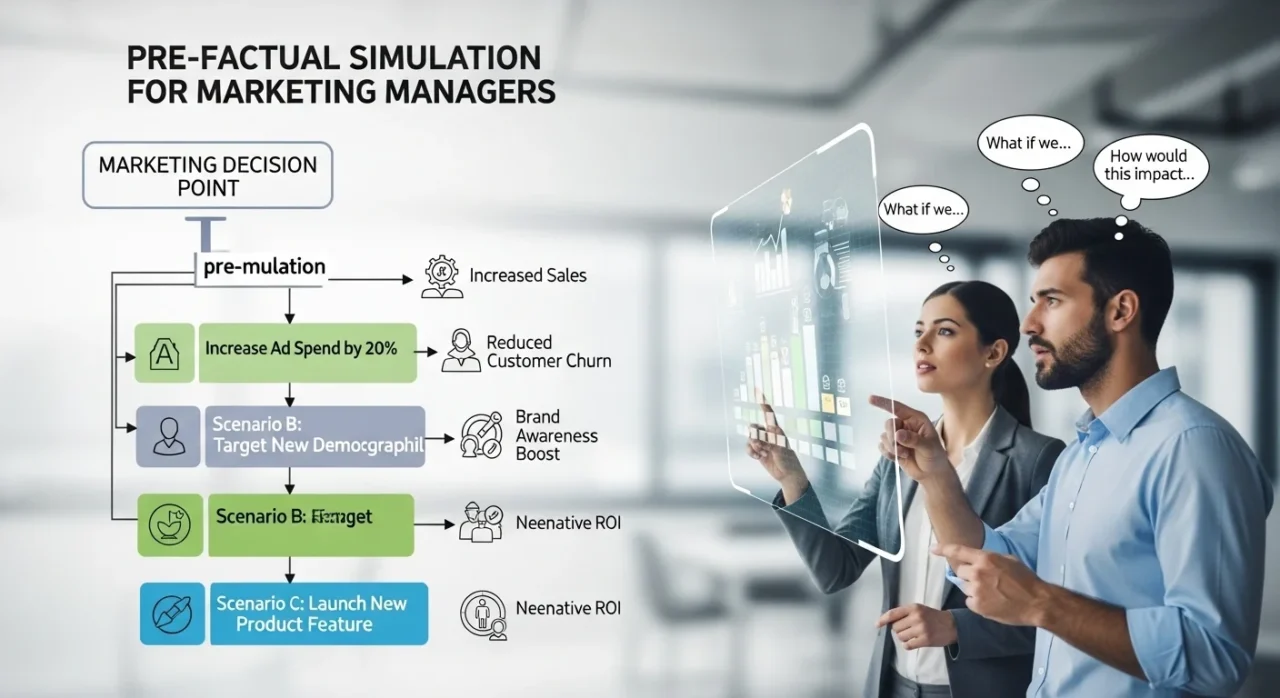Pre-Factual Simulation: Shaping Tomorrow’s Marketing Today

Learn About Pre-Factual Simulation: Shaping Tomorrow’s Marketing Today
Tired of marketing that reacts to yesterday’s news? What if you could simulate tomorrow’s outcomes before they even happen? It’s a tantalizing thought. To move beyond mere prediction and step into the realm of pre-emptive strategy.
Enter MatrixLabX: Not just another prediction engine promising to peer into the swirling mists of the future, but a total powerhouse in what they term “pre-factual simulation.” It’s a bold claim, suggesting not just foresight, but the power to shape what’s to come.
This isn’t just about forecasting next quarter’s sales; it’s about actively shaping your future in a business landscape that feels increasingly chaotic and unpredictable.
Get ready to dive into the ultimate “what if” machine for your business! A digital oracle, perhaps, but one grounded in the cold, hard logic of algorithms and data. The question is, can it truly deliver on this promise?
Pre-Factual Simulation: The New Competitive Advantage in Sales and Marketing
In an age of predictive analytics, Pre-Factual Simulation takes forecasting a step further. Instead of simply predicting what might happen, it simulates what will likely happen next based on hypothetical decisions, enabling sales and marketing teams to engineer outcomes proactively rather than react to them.
Unlike retrospective analysis or even real-time dashboards, Pre-Factual Simulation operates on a dynamic, scenario-driven model. Think of it as the “flight simulator” for go-to-market teams: what happens if we increase ad spend in Q3? What if we reduce sales headcount in underperforming regions? What if we shift content strategy from top-of-funnel to BOFU campaigns? These are no longer theoretical discussions — they become testable scenarios with measurable impact projections.
Why It Matters: Pre-Factual Simulation
Sales and marketing teams are often locked into post-factual decision-making. KPIs lag behind actions, and by the time data shows what’s not working, it’s already too late. Pre-Factual Simulation flips the script. It brings predictive foresight to frontline execution — empowering teams to make evidence-based decisions before the consequences arrive.
For sales teams, this involves modeling quota outcomes across various account prioritization strategies, lead response times, and territory configurations. For marketing, this involves simulating the impact of messaging changes, content distribution timing, and budget reallocations on conversion paths and campaign ROI.
How Pre-Factual Simulation Works
Pre-Factual Simulation typically uses a combination of:
- Machine learning models trained on historical CRM, web, and campaign data
- Agent-based modeling that simulates interactions between leads, reps, and marketing channels
- Dynamic feedback loops that update outcomes based on evolving inputs
AI models don’t just crunch numbers — they understand behavior over time. For example, a simulation might show that delaying lead response by 12 hours reduces conversion probability by 22% in high-velocity B2B SaaS. Or that increasing remarketing exposure by 30% improves deal acceleration by 15% in mid-funnel ecommerce.
These simulations are not fantasy. They are powered by real-time data, real customer journeys, and behaviorally accurate models trained on millions of data points.
Strategic Advantage Using Pre-Factual Simulation for Business
The strategic edge is clear:
- Shorten feedback loops: Know the impact of decisions before committing to spend or headcount
- Reduce guesswork: Base GTM strategy on outcome-driven simulations instead of gut instinct
- Increase agility: Run “what if” scenarios quickly to adapt to changing markets or competitor moves
- Optimize investments: Allocate budget where it delivers the highest simulated ROI, not where it feels right
Pre-Factual Simulation is more than just better planning. It’s about de-risking growth. It fosters a proactive culture where decisions are validated before execution, rather than after failure.
For sales and marketing leaders navigating volatile markets, Pre-Factual Simulation is not a luxury — it’s a necessity. In a world flooded with dashboards and delayed insights, this approach delivers the one thing most GTM teams are missing: a reliable preview of tomorrow’s outcomes, based on today’s choices.
The companies that embrace this shift will not only predict the future — they’ll start engineering it.
1. MatrixLabX: Your Marketing’s New Brain?

The modern marketing landscape is often described as a battlefield of fragmented tools, endless spreadsheets, and creative gridlock. MatrixLabX presents itself as a solution to this chaos, an autonomous AI marketing platform designed for “zero-labor” growth.
The very phrase conjures images of a marketing utopia, where campaigns hum along effortlessly, freeing human marketers to focus on… well, what exactly? Vision, while the AI handles the operational velocity.
At its heart lies proprietary NeuralEdge™ AI and industry-specific “agentic systems.” These aren’t just algorithms; they’re framed as a super-smart digital marketing team, tirelessly handling strategy, execution, and optimization.
Think of them as 42 specialized AI marketing agents strategizing and executing campaigns in real-time. AIProdPad helps streamline product launches, AIContentPad churns out content across various media, and AIBrandPad ensures brand consistency across all touchpoints. It’s a compelling vision, a symphony of AI agents working in perfect harmony.
But what sets MatrixLabX apart is its “glass box” approach. No opaque algorithms here, no “black box” mystery. Instead, you can build custom models of your market, customers, and sales funnels.
This promises not just what happened, but a deep understanding of the why. This transparency is crucial; in an age of increasing skepticism towards AI, the ability to see under the hood is a major selling point. It moves beyond ephemeral AI tools, which offer tactical shortcuts without strategic insight.
And the promise? To slash operational marketing costs by up to 70%! It’s a staggering claim, one that demands scrutiny. Such a reduction in costs could be transformative for businesses of all sizes.
2. Pre-Factual Simulation: What’s Your “What If”?
At the core of MatrixLabX lies “pre-factual simulation,” a concept that transcends mere forecasting. It’s about mentally rehearsing potential future scenarios, asking: “If I take action X, will it lead to outcome Y?” It’s more than just daydreaming; it’s about proactively planning for tomorrow.
Unlike “counterfactuals” – those agonizing “what if… / if only…” thoughts about the past – pre-factual thinking is purely about the future. It’s about learning from potential missteps before they happen.
This mental gymnastics helps you weigh options, assess risks, and make smarter choices before you commit.
It’s like running a mini-simulation in your head, a trial run for your strategic decisions. It’s about anticipating the ripples of your actions before you even drop the stone into the pond.
3. From Ancient Philosophers to AI Brains: A “What If” History
The notion of “what if” is hardly new. Turns out, philosophers like David Hume and René Descartes were asking “what if” centuries ago, pondering the nature of reality and how we mentally simulate states.
These early thinkers grappled with the very foundations of knowledge and perception, laying the groundwork for our modern understanding of cognition.
Fast forward to the mid-20th century with Herbert Simon’s work on “bounded rationality,” showing how humans naturally consider alternatives to improve decisions.
Simon’s insights revealed the limitations of human decision-making and the importance of considering multiple options.
The 1980s saw the rise of “counterfactual thinking” in psychology – those “what if… / if only…” thoughts about the past. Researchers have found that imagining alternatives enables us to learn from mistakes and prepare for the future. It’s a powerful tool for self-improvement and adaptation.
By the 1990s, the need for a specific term for future-oriented “what ifs” emerged. The term “prefactual” was coined and refined over the years to mean a conditional “if-then” proposition about a future action and its likely outcome.
It’s a testament to our innate desire to anticipate and prepare for what lies ahead.
4. The Buzz Right Now: What People Are Saying about Pre-Factual Simulation
MatrixLabX is positioning itself as the platform for companies ready for truly autonomous AI marketing, ditching disconnected tools for a unified, AI-first system.
They’re not just playing in Google’s sandbox; MatrixLabX and Matrix Marketing Group are seen as pioneers in ensuring brand visibility not just on Google, but across conversational AI platforms like ChatGPT, Gemini, and Claude. This is crucial in an era where search is evolving beyond traditional search engines.
And the real-world results? Customers are reportedly achieving significant wins, such as doubling content output while halving production time with AIContentPad, and effortlessly expanding brands into new markets with AIBrandPad. These are impressive claims, suggesting a tangible impact on marketing efficiency and effectiveness.
But perhaps the most compelling argument for pre-factual thinking is its relevance in today’s world. It’s crucial for effective prospection, setting and achieving goals, and even regulating your emotions.
It helps people form intentions and influences how they interact with emerging tech like generative AI, shaping their perceptions of benefits and risks. In a world of rapid technological change, the ability to anticipate and adapt is more critical than ever.
5. The AI Ethical Maze: Are There Any Traps?
The research didn’t uncover any specific controversies directly linked to MatrixLabX. However, the broader ethical questions surrounding AI are certainly relevant.
Handling vast amounts of sensitive data always raises questions about consent, ownership, and misuse. MatrixLabX’s “glass box” aims to build trust here, but the challenge remains.
Can these super-smart algorithms accidentally perpetuate societal biases from their training data? It’s a constant concern for any AI system.
Even with a “glass box” approach, understanding every decision made by complex AI systems can be a challenge. How much insight do users truly get?
If an autonomous AI makes a mistake or causes unintended harm in a marketing campaign, who’s on the hook?
While “zero-labor” sounds appealing, it may lead to an over-reliance on AI, potentially reducing human oversight or even creating an “experience gap” in marketing teams.
While aiming for cost reduction, the initial investment in such a comprehensive, cutting-edge AI platform might still be a consideration for some businesses. These are all valid concerns, potential pitfalls on the path to AI-powered marketing.
6. Glimpse into Tomorrow: The Future is Now-ish

The future, according to MatrixLabX, involves continued deep integration of AI into marketing, with the platform pushing towards a fully autonomous AI marketing system. The Symphony AI Suite is expected to expand, providing even more specialized AI agents to streamline every conceivable marketing function.
A strong focus will be on making advanced, sophisticated AI solutions accessible and impactful for small and medium-sized businesses, democratizing capabilities previously only available to giants.
The “what if” gets smarter: Predictive analytics and pre-factual simulation will continue to intertwine with advanced AI and machine learning, offering real-time, hyper-accurate “what-if” analyses powered by massive data streams.
Explainable AI becomes standard: As AI models grow in complexity, the demand for transparency and interpretability (Explainable AI, or XAI) will increase, making those “what if” outcomes crystal clear.
And finally, future-proof your career: As AI takes over more operational tasks, marketing professionals will need to evolve, focusing on strategic implementation, AI oversight, and mastering this new “what if” frontier.
MatrixLabX, born from Matrix Marketing Group in 2011, aims to transform marketing by addressing “content chaos” through AI. Their vision is of AI agents automating workflows, not just tasks.
In September 2023, they launched AIProdPad, AIBrandPad, AIContentPad, and AILegalPad, showcasing their commitment to AI-driven solutions. Looking ahead, MatrixLabX plans to offer an autonomous AI marketing system powered by NeuralEdge AI.
The Symphony AI Suite, launched in November 2024, includes 42 AI agents to streamline processes. Their goal is to provide SMBs with the tools needed to create strategic models from data.
MatrixLabX is at the forefront of AI advancements in AI Agentic Systems in marketing, and partners with Matrix Marketing Group to provide intelligent systems powered by Multi-Agent RAG Systems. MatrixLabX focuses on strategic insight vs. opaque tactics and offers AI Core, AI Pro, AI Ultra, and NeuralEdge.
Matrix Marketing Group Launches Performance-Based Pricing for Mid-Market Companies
Powered by our proprietary MatrixLabX AI, we’re eliminating traditional retainers to link our compensation directly to your results—reducing risk and maximizing your ROI.
A Fundamental Shift in Accountability
We’re moving away from outdated models that reward effort to a modern approach that guarantees results.
The Old Way: Traditional Agencies
- ✖Pay for effort, not outcomes
- ✖High financial risk on your budget
- ✖Opaque ROI and unclear value
- ✖Misaligned incentives and goals
The Matrix Way: Performance Partnership
- ✔Pay only for measurable results
- ✔Minimized risk, maximized budget efficiency
- ✔Crystal-clear, transparent ROI
- ✔A true partnership with aligned success
Flexible, Performance-Based Pricing
Choose the model that best fits your business goals. Each one is designed to ensure our success is directly tied to yours.
Pay Only for Qualified Leads
This model is ideal for businesses focused on filling their sales funnel with high-intent prospects. You only pay when we deliver a lead that meets your specific criteria, validated by our AI for quality, ICP fit, and engagement level. It’s a straightforward way to guarantee your marketing spend translates directly into sales opportunities.
The Intelligence Behind the Results: MatrixLabX
Our proprietary AI platform is the engine that powers our performance models, moving beyond simple automation to deliver intelligent, self-improving campaigns.
Data Ingestion & Analysis
MatrixLabX analyzes real-time signals from your marketing channels, CRM, and the wider market to build a deep understanding of your audience.
AI-Powered Optimization
The AI core uses predictive analytics for lead scoring, campaign optimization, and dynamic adjustments to ensure maximum efficiency.
Measurable Outcomes
The result is a stream of qualified leads, higher conversion rates, and a clear, transparent ROI that you can track in real-time.
The Proof is in the Performance
We’re not just following a trend; we’re leveraging a proven model we helped pioneer, backed by industry data and decades of experience.
0
Higher ROI
Reported by clients using our performance pricing models vs. traditional retainers.
0
Industry Shift
Of top agencies expected to abandon hourly rates for value-based pricing by 2025.
0
Pioneering Since
When we launched the industry’s first successful paid performance public relations program.
Client Success: Performance vs. Traditional Models
Ready to Align Your Marketing with Your Growth?
Our performance-based model is designed for mid-market companies with revenues between $5 million and $100 million. If that’s you, let’s talk.
Conclusion and Pre-Factual Simulation
MatrixLabX isn’t just about predicting the future of marketing; it’s about giving businesses the tools to simulate countless possible futures and choose the most advantageous path. It represents a paradigm shift: from reacting to “what happened” to proactively asking “what if we…?” and then making it happen.
Is your business ready to embrace the power of pre-factual thinking and truly shape its destiny? The “what ifs” are calling, beckoning us to explore the uncharted territories of possibility.
It’s a compelling vision, but one that requires careful consideration, ethical awareness, and a willingness to embrace the power – and the potential pitfalls – of AI.
AI Playbook Selector by Industry
Find Your AI Marketing Playbook
Pick your industry → go straight to your tailored AI Playbook.



